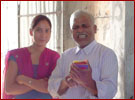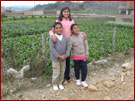
|
|
Situation of children and women in Nepal 2006 Section on background to pregnancy and birth of child Rural women in Nepal often have very heavy workloads that include heavy lifting and physical labour in the fields during busy agricultural periods as well as routine household chores. Indications are that women's workloads remain relatively unchanged during pregnancy. The lack of special care afforded to pregnant women is also apparent in the figures for gender-based violence. Almost 25 per cent of maternal deaths occur during pregnancy; many of these are the result of physical violence or a general lack of care . The health-seeking behaviour of a woman during pregnancy is linked to the survival of her child and herself. Regular antenatal care can ensure that the health of a woman is monitored, and that she receives supplements, medication and advice that will improve the chances of a successful outcome to her pregnancy. About half of all pregnant women in Nepal receive some form of antenatal care, although few receive the recommended four visits . The birth of a child The low levels of skilled attendance at childbirth endanger the lives of many Nepali mothers and their newborns. Currently, at least 539 mothers die for every 100,000 live births . This translates to about one woman every two hours. Most women give birth at home, with less than one in 10 births taking place in a health facility . Over threequarters of women are assisted in labour by relatives and friends or untrained Traditional Birth Attendants. Only about 13 per cent are attended by a doctor, nurse, or someone with appropriate midwifery skills . The remaining one in 10 births are delivered without any assistance. Thus, for most deliveries, there is no one present to safely handle the common complications that can kill the newborn baby. Birth and the first month of life are precarious for the Nepali child. Over four out of 10 children who die before their fifth birthday, die during the first month, the majority of them during the first week . Birth asphyxia is a common complication of delivery in Nepal; it most often occurs when a delivery is not assisted by a skilled attendant. It accounts for nearly half of newborn deaths in the community and at least a quarter of newborn deaths in hospital. Infection is also a common problem. At least a quarter of newborn deaths in Nepal are the result of infections such as septicaemia, pneumonia, diarrhoea and meningitis . Many infections are contracted from the unhygienic conditions in which birth takes place and from unclean practices associated with delivery by unskilled attendants. Some women are obliged to give birth in outhouses that are little more than cowsheds (chaupadi). Although neonatal tetanus used to be a major problem in Nepal, an extensive vaccination programme targeting pregnant women has reduced its incidence. Breastfeeding strenghtens the baby's immune system and is almost universal in Nepal. However, it is delayed by at least 24 hours for about one in three babies . Nepal has a particularly high incidence of lowbirth- weight deliveries, with over a quarter of newborn babies weighing less than 2.5 kg . These newborns are more susceptible to hypothermia and acute respiratory infections. Over three-quarters of newborn deaths in Nepal occur in low-birth-weight babies . Hypothermia is also common, particularly during winter, and contributes to the death of many newborns from infections and other causes. It is a widespread practice to bathe newborns soon after delivery, with over nine in 10 babies being washed in their first hour. In addition, a third of babies are not quickly wrapped in warm clothing following their birth . About one in 25 children born in Nepal die during the first month of life . The material for this page is from www.un.org.np/reports/UNICEF/2006/situation-analysis/conver-page.pdf
|




